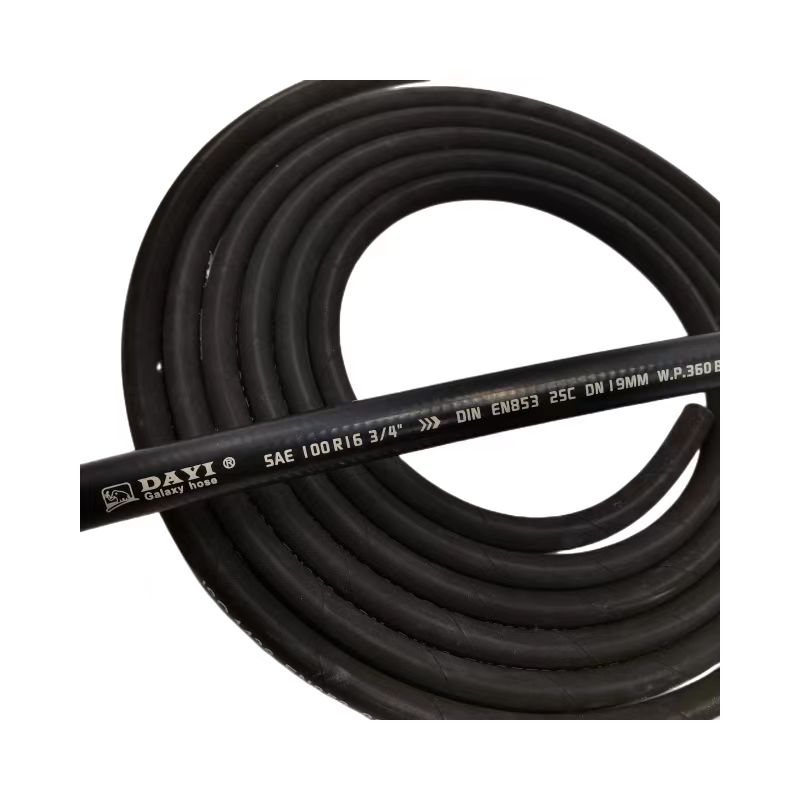1 月 . 06, 2025 19:04 Back to list
hydraulic rubber hose
Choosing the right hydraulic rubber hose for your equipment can dramatically influence the efficiency and lifespan of the machinery you are operating. With the multitude of options available in the market, understanding the product nuances can provide a significant advantage. Having spent over two decades in the field of hydraulic systems, I have encountered a wide spectrum of hydraulic hoses, each with unique benefits and challenges. This article aims to share insights gained from hands-on experience, providing a comprehensive guide on hydraulic rubber hoses.

Hydraulic rubber hoses are indispensable components in hydraulic systems; they serve as flexible pipelines that transmit hydraulic fluids between components such as pumps, valves, and actuators. The choice of a hydraulic hose largely depends on application-specific requirements—pressure levels, fluid conveyance, environmental conditions, and system specifications. To ensure optimal performance, it's crucial to focus on hoses that offer robustness and adaptability.
A crucial aspect to examine is the hose's pressure rating. A mismatch in pressure tolerance can lead to catastrophic failures. When selecting a hydraulic rubber hose, it is essential to ascertain whether it's single-wire, double-wire, or multi-spiral hoses, as each type offers varying degrees of working and burst pressure capabilities. For heavy-duty machinery, multi-spiral hoses are often recommended due to their superior strength and durability.

The construction material of the hydraulic rubber hose plays a pivotal role. Using hoses made from high-quality synthetic rubber ensures excellent flexibility, longevity, and resistance to abrasion, oil, and extreme temperatures. A frequent challenge encountered in my practice is ensuring that the hoses can withstand the hydraulic fluid type—whether it's oil-based, water-based, or synthetic. Compatibility not only prevents degradation but also secures the safety and reliability of the system.
hydraulic rubber hose
Additionally, the operating environment drastically affects the choice of hose. In scenarios where exposure to sunlight, ozone, or other environmental hazards is frequent, selecting hoses with additional protective coverings can prevent premature wear and extend service life. Each hydraulic system's environment can impose different demands—understanding these and customizing hose characteristics accordingly is crucial.
The role of hose fittings and connectors must not be overlooked. They are vital in establishing leak-proof systems and should be chosen to complement the hose's dimensions and material characteristics. My decades of experience have shown that precision in selecting compatible fittings can significantly reduce downtime and maintenance costs.
Lastly, ensuring your hydraulic system's efficiency also involves adhering to a consistent maintenance schedule. Regular inspections for signs of wear, such as cracks or bulges, can preempt failures and maintain system integrity. Training personnel in recognizing these signs and replacing hoses before they malfunction is an investment in safety and performance.
In conclusion, hydraulic rubber hoses are invaluable in ensuring fluid power systems operate smoothly and efficiently. By choosing the appropriate hose type, material, fitting, and maintenance routine, you can protect your machinery and ensure its optimal function. Informed decisions in this domain emanate from a blend of technical knowledge and practical experience, a twofold approach that forms the backbone of effective equipment management.
-
EN857 2SC Hydraulic Hose Suppliers OEM & China Manufacturers
NewsMay.30,2025
-
51mm Hydraulic Hose Manufacturer China OEM Durable & Custom Solutions
NewsMay.30,2025
-
OEM Rubber Air Hose Supplier Durable Custom Solutions
NewsMay.29,2025
-
High-Pressure Wrapped Cover Steel Wire Spiral Hydraulic Hose Supplier
NewsMay.29,2025
-
Rubber water suction and discharge hose
NewsMar.07,2025
-
SAE 100 R6/EN 854 R6 Fibre Braided Oil Hose
NewsMar.07,2025



